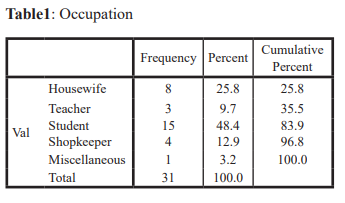Abstract
Introduction: Vocal fold nodules present frequently
in the ENT outpatient department. Treatment of
vocal nodules involves a variety of voice therapies
and micro laryngeal surgery. The aim of the study
was to evaluate the effectiveness of voice therapy
for patients with vocal fold nodules in eliminating
or reducing the vocal nodules, rate improvement in
voice quality after therapy and to evaluate how many
sessions of therapy was required. The study wAs
conducted in Western Regional Hospital, Pokhara,
Department of ENT, Head and Neck Surgery.
Materials and Methods: A single institutional
retrospective observational longitudinal study was
conducted .Total 31 patients with diagnosis of
vocal fold nodules who underwent voice therapy
sessions from September 2007 to September 2008
were taken from the records for the study. Patient
demographics and post therapy outcomes were
analyzed using SPSS 21.
Results: Mean age was 35.57+/-12.53 SD of mean.
Majority were females (22) and Female: Male ratio
was 2.4:1. The mean percentage of patients who
attended less than 6 sessions were 60%. Those
who attended more than 6 sessions was 40%
.Voice quality showed signs of improvement in 22
patients and no change in 3 patients. Out of those
who attended, vocal fold nodules disappeared in 20
patients, persisted as grade 1 size in 2 patients and
3 patients didn’t show any signs of improvement.
Conclusion: Our results have shown promising role
of conservative management by voice therapy for
vocal nodules thus lessening the need for surgery
References
ELM, Martins MG, Gonçalves TM, Dias NH.
Voice disorders: etiology and diagnosis. J Voice.
2016;30(6):761–e1.
2. Won SJ, Kim RB, Kim JP, Park JJ, Kwon MS,
Woo SH. The prevalence and factors associate with
vocal nodules in general population. Medicine
(Baltimore). 2016 Sep 30;95(39).
3. Ghosh SK, Chattopadhyay S, Bora H,
Mukherjee PB. Microlaryngoscopic study of 100
cases of hoarseness of voice. Indian J Otolaryngol
Head Neck Surg. 2001;53(4):270–272.
4. Holmberg EB, Hillman RE, Hammarberg B,
Södersten M, Doyle P. Efficacy of a behaviorally
based voice therapy protocol for vocal nodules. J
Voice. 2001;15(3):395–412.
5. Silberman HD, Wilf H, Tucker JA. Flexible
Fiberoptic Nasopharyngolaryngoscope. Ann Otol
Rhinol Laryngol. 1976 Sep 1;85(5):640–5.
6. Ogawa M, Inohara H. Is voice therapy
effective for the treatment of dysphonic patients
with benign vocal fold lesions? Auris Nasus
Larynx. 2018 Aug;45(4):661–6.
7. Tang SS, Thibeault SL. Timing of Voice
Therapy: A Primary Investigation of Voice
Outcomes for Surgical Benign Vocal Fold Lesion
Patients. J Voice. 2017 Jan;31(1):129.e1-129.e7.
8. Van Houtte E, Van Lierde K, D’Haeseleer E,
Claeys S. The prevalence of laryngeal pathology
in a treatment-seeking population with dysphonia:
Prevalence of Laryngeal Pathology. The
Laryngoscope . 2010 Feb;120(2):306–12.
9. Martins RHG, do Amaral HA, Tavares ELM,
Martins MG, Gonçalves TM, Dias NH. Voice
Disorders: Etiology and Diagnosis. J Voice. 2016
Nov;30(6):761.e1-761.e9.
10. Nuss RC, Ward J, Huang L, Volk M,
Woodnorth GH. Correlation of Vocal Fold Nodule
Size in Children and Perceptual Assessment of
Voice Quality. Ann Otol Rhinol Laryngol. 2010
Oct;119(10):651–5.
11. Oates J. Auditory-Perceptual Evaluation of
Disordered Voice Quality. Folia Phoniatr Logop.
2009;61(1):49–56.
12. McCrory E. Voice therapy outcomes in vocal
fold nodules: a retrospective audit. Int J Lang
Commun Disord. 2001;36(S1):19–24.

